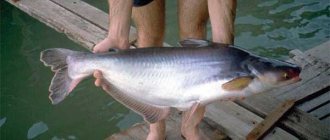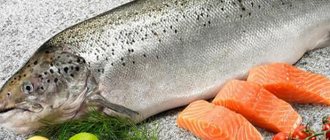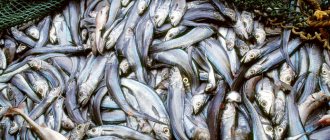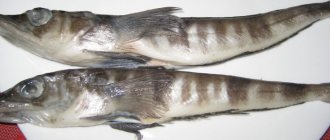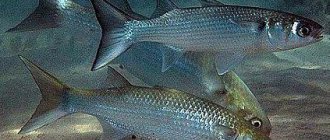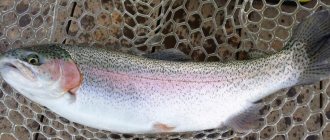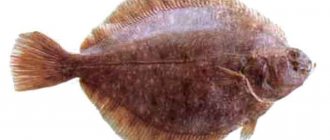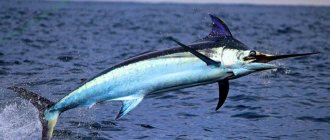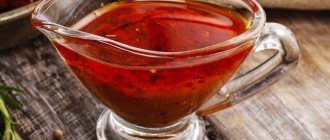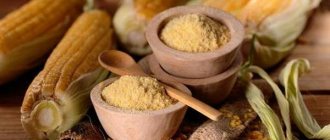Pollock carcass
Good afternoon, dear readers! Human health, first of all, depends on proper nutrition, so your diet should include more seafood rich in vitamins, minerals, and Omega-3 essential for the body.
I recommend paying special attention to pollock fish. Even gourmets will appreciate the taste of this fish. Its tender meat is ideal for preparing various dietary dishes.
But I will talk about the benefits and harms of pollock in more detail in this article.
Pollock: what kind of fish and where is it found?
Pollock is a predatory marine fish from the cod family. It lives in the waters of the Atlantic near the coasts of Norway and Iceland. In Russia it is caught on an industrial scale, mainly in Murmansk.
Pollock has an elongated body with a pointed head, silver in color with a characteristic light stripe. It can reach up to 90 cm in length and weigh up to 17 kg. A distinctive feature of this fish is its elongated lower lip. Pollock is considered a close “relative” of hake, cod, haddock and pollock. The predator feeds mainly on crustaceans, plankton and small fish.
Due to its habitat in salt water, the meat of this fish is protected from infection by parasites, so it can be pickled and salted without additional heat treatment. Recently, pollock catches have increased so much, due to the huge demand for meat, that the entire catch had to be regulated and controlled in order to stabilize the population.
People sometimes confuse saury and pollock, but these are two different fish, and the confusion most likely arises due to the fact that saury can be found more often on the shelves of our stores.
Pollock in natural conditions
Independent socio-political portal
Today, on the shelves of markets and supermarkets in Petropavlovsk-Kamchatsky (Vega, Shamsa, etc.), along with such traditional Kamchatka fish products as salmon, herring and pollock, you can find a considerable amount of a wide variety of fish delivered to Kamchatka from other regions. The names of some of them (for example, talisman, pangasius or tilapia), as a rule, do not mean anything to the average buyer, especially since they are sold in the form of frozen fillets. Among such fish, undoubtedly, is pollock. Since most residents of the regional center can hardly imagine what it looks like, it is obviously worth telling about it in more detail. It turns out that pollock is a close relative of cod, widespread in the North Atlantic Ocean along the coast of Europe from the Bay of Biscay in the south to Spitsbergen and Murman in the north, and off the coast of North America - from Cape Cod to the Gulf of St. Lawrence. There are rare cases of its capture in the Baltic Sea. Pollock has an elongated body with three dorsal and two anal fins, a large terminal mouth with a somewhat protruding lower jaw. Unlike cod, its chin barbel is very short and barely noticeable, the caudal fin has a deep notch, and the slightly curved lateral line is characterized by a whitish tint. The back of the pollock is usually steel or olive in color, and the belly is silvery-white. Pollock leads a schooling pelagic lifestyle at depths of up to 250 m, living both in the water column in the bathymetric range of 40-100 m and near the bottom. Usually in its distribution it stays close to the coast, does not go beyond the shelf, and therefore is rarely found in the open sea. Every year, pollock makes long seasonal feeding and spawning migrations. Its lifespan reaches 30 years, its maximum length is 120 cm, and its body weight is over 20 kg (the largest specimen, caught by one of the fishermen in Salstraumen in northern Norway, weighed 22.3 kg). But such giants are extremely rare, so the bulk of the catches are usually individuals aged 5-12 years, measuring 60-90 cm with a body weight of up to 5-10 kg. Juvenile pollock feeds mainly on small crustaceans, eggs and fish fry. However, having reached a certain size, it switches to a predatory lifestyle, and therefore its main food source is various small schooling fish (primarily capelin, sprat, sand lance and juvenile herring), as well as shrimp. It is typical that adult pollocks hunt, as a rule, in large flocks, surrounding the prey on all sides. If the attack occurs near the surface of the sea, then during the hunt they sometimes make a loud noise. Pollock, like cod, reproduces in the coastal zone in the spring. Since spawning occurs at a water temperature of 6-10 ° C and oceanic salinity, its sexually mature individuals migrate from northern regions to more southern ones (for example, fish feeding in the Barents Sea go to spawn on the shores of Norway, where the influence of the Gulf Stream is felt). Each female lays from 2 to 6.5 million eggs, which develop in the water column for about two weeks. During the development process, the eggs, and then the larvae that emerge from them, are carried by sea currents over considerable distances. They reach the Russian shores with the waters of the relatively warm North Cape Current. In the first months of life, juvenile pollock stays mainly in bays, rarely being found far from the shore. After completing spawning, adult individuals migrate back to the northern regions to their feeding grounds. Although at the beginning of the last century, pollock was classified as a secondary fishery object, today it is considered a valuable food fish, occupying third place in terms of catch volume among cod in Western Europe after cod and haddock. In general, up to 350-400 thousand tons of pollock are harvested annually in the world (the world record catch of 407 thousand tons was registered in 1965). A significant share of the catch occurs in European countries such as Norway, Germany, Denmark, Great Britain, France, as well as Canada, Russia and the USA. The main fishing gear for pollock are trawls, purse seines and gill nets. Pollock is sold fresh, frozen, and sometimes salted. It usually enters the Russian market in the form of fillets made from fish caught by domestic fishermen or imported from Norway. As evidenced by the results of technological research, pollock is an excellent source of proteins and a real record holder for iodine content. In addition, its grayish meat contains a lot of vitamin B, selenium, potassium and sodium. Like all other cod fish, the liver of pollock is highly valued. In terms of its taste, pollock is practically not inferior to cod (according to some lovers of fish dishes, it even surpasses it). However, the demand and prices for products from this fish are today lower than those from cod, since the latter is the most famous. You can prepare pollock in a variety of ways. Many people really like its fillet, breaded and fried in hot oil (it is included in the Filet-o-Fish sandwich). Pollock is very tasty when cooked with seasonings in salted water and served with fried or boiled potatoes and vegetables. It is no less good in soup, stewed with vegetables or baked in the oven. It is typical that pollock meat turns white during cooking. Among other things, canned food called “sea salmon” is prepared from pollock. To do this, thin slices of its salted fillet are soaked in refined fish oil and painted with special food coloring in the pinkish-orange color that is characteristic of salmon meat. Canned food has good taste, resembles salmon, but is much cheaper, and therefore is in great demand on the European market. In conclusion, it should be noted that many gourmets prefer pollock to any other white fish, arguing that those who have not tried it do not know what real fish is, since only pollock has a unique and at the same time intense fishy taste. Today, residents of Petropavlovsk-Kamchatsky have the opportunity to assess for themselves the validity of this statement.
Chemical composition of pollock meat
Pollock meat has a dense consistency, slightly grayish color, pleasant taste, it cannot be called dry. This meat should appeal to gourmets and connoisseurs of fish dishes. It is much cheaper than cod, but in terms of taste and health benefits it is no worse.
Of the vitamins that are present in pollock meat, we can note - B vitamins (B1, B2, B12), as well as Vitamin A, Vitamin K, Vitamin PP and E. The most minerals are sodium, potassium, iron, selenium, zinc , phosphorus, manganese, magnesium, nickel.
Pollock: beneficial properties
1. Phosphorus is necessary for the proper functioning of the entire musculoskeletal system, as well as for the functioning of the brain.
2. Iodine normalizes the functioning of the thyroid gland.
3. Calcium is necessary to strengthen bones and tooth enamel.
4. Zinc is needed for the proper functioning of the hormonal system in men and women.
5. Cobalt and nickel are necessary for proper hematopoiesis and normalization of blood pressure.
6. Molybdenum helps improve metabolic processes in the body and normalize hemoglobin levels.
7. The complex of vitamins is necessary for the proper functioning of the liver, thyroid gland and pancreas.
8. Regular consumption of pollock will help strengthen the immune system and speed up the process of cell regeneration.
9. Due to the high content of folic acid, this fish is recommended to be included in the diet of pregnant women and couples who are planning to have a child.
10. Fish is rich in proteins and is almost as nutritional as lean beef, so it can be included in the diet of people who do not eat meat. Moreover, proteins from fish are absorbed much better than proteins from pork or beef.
11. Pollock meat should be in the diet of people suffering from diseases of the gastrointestinal tract, such as gastritis, pancreatitis, stomach or duodenal ulcers.
12. Young children can gradually introduce saury dishes into their diet from the age of eight months in the form of soft puree cutlets or light soups.
On a note! The healthiest pollock is baked or steamed; this meat is recommended to be consumed in the postoperative period for a speedy recovery of the body.
Canned pollock in oil
Description of the pollock
The body of the pollock is elongated, the head is pointed, and there is a small antennae on the chin. Pollock has 2 dorsal and 2 anal fins. A distinctive feature of this species is a light stripe that stretches along the entire back. The structure of the pollock's lower jaw is unusual; it is pushed forward, so during an attack the predator picks up its prey from below.
The color of the back is olive, or can be steel with a white border. The belly is silvery. The tail is straight with a characteristic notch. The head is dark.
An adult pollock reaches an average length of 85-95 centimeters and weighs about 17 kilograms.
Pollock lives throughout the North Atlantic and northern North Sea, and is rarely found in the Baltic Sea.
The world's largest pollock, which weighed 22.3 kilograms, was caught in northern Norway.
Canned pollock
Pollock meat is tasty and healthy in any form, and canned meat is no exception. The best are considered to be canned goods prepared immediately after extraction directly on the ship. As a rule, the manufacturer of such products is Murmansk or Norway.
From canned food you can find:
1. Pollock in oil or its own juice.
2. Pollock with vegetables.
3. Liver or caviar.
Pollock caviar has a slightly salty taste, is very tender, and is good for sandwiches with butter.
Pollock liver is very similar to cod liver and is also rich in Vitamin D; it can be used to prepare salads or sandwiches.
When choosing canned food, pay attention to the composition! Apart from the fish itself, water, black pepper and spices, there should be no other preservatives or food additives. The shelf life of such products is usually two years.
Steak pollocks in nut breading
Secrets of cooking
Many housewives believe that pollock has a rather bland taste and is a little dry. For this reason, it is not in such demand in stores and supermarkets as pink salmon or salmon. Indeed, if you simply fry it in oil, like any river fish, it will be very dry and practically inedible. The best way to prepare this variety is to simmer over low heat in a deep bowl, adding a sauce made from flour and white wine. During the stewing process, sautéed onions and roots (carrots, parsley, finely chopped celery root) are also added. Here are some more ways to prepare sea fish:
- Cutlets made from pollock fillet, minced through a meat grinder. To make them fluffy, you need to add a beaten egg or one grated potato;
- Pollock soup. To make the broth rich and fatty, you can add other varieties to the fish soup, for example, salmon or pink salmon;
- Yeast dough pie filled with mashed potatoes and fish fillet;
- Fish zrazy with mushrooms.
Canned pollock
Sometimes canned pollock ends up on supermarket shelves. The best of them are considered to be those prepared directly on the ship, immediately after catching the fish. As a rule, they are made in Murmansk or Norway. Here are the main types of such canned food:
- Pollock in oil or in its own juice;
- Pollock with canned vegetables;
- Pollock liver;
- Caviar.
The caviar of this fish has a delicate, slightly salty taste; it goes well with sandwiches made from black bread with butter. Pollock liver is rich in vitamin D and is almost as concentrated as cod liver. It can be added to salads or spread on sandwiches instead of butter. Fans of home canning can also independently preserve pollock fillets using an autoclave; the shelf life of such products is no more than two years (subject to all storage conditions).
This variety is practically never found in dried or dried form. When choosing canned food, you should carefully study their composition. The ideal option is a jar that says: “saithe, water, black pepper (or other spices)”, without preservatives or other food additives.
Fish selection criteria
When choosing pollock in a supermarket or market, you should first of all pay attention to its smell. It should be fresh, sea-based. A musty smell indicates that the product is no longer fresh, and you should refrain from purchasing it.
When purchasing frozen fillets, it is not recommended to purchase products in opaque packaging. If there are no other options, the packaging needs to be shaken thoroughly. A characteristic noise when shaking indicates that there is a large amount of ice inside. This happens when fish is repeatedly frozen and thawed, as well as in cases where the manufacturer deliberately wants to increase the weight of the product due to ice.
If the fish is slippery, sticky, or unpleasant to the touch, this also indicates poor quality and possible staleness of the product. The scales of high-quality pollock should be shiny, not dull.
“Seafood” is an indispensable product in the diet of a modern person. In order for sea fish to be tasty, you need to prepare it correctly and choose quality products. Pollock is one of its most valuable varieties. It’s a shame that so far not all gourmets have been able to appreciate it. It should occupy an important place in the diet of those who care about their health, along with cod, hake and other inhabitants of the northern seas. Preparing pollock is very easy, the main thing is to make it soft and aromatic, spices and a variety of sauces (both store-bought and homemade) will help with this.
How to cook
Pollock meat will be tasty and healthy in any form. The simplest option is to fry the fillet in a frying pan in batter or any breading until golden brown with the addition of various spices, but you can boil, bake, can, or roll it into minced meat for cutlets.
This fish can be smoked and marinated. You will get very tasty and juicy meat if you bake it in foil with the addition of herbs, fish spices, lemon juice, you can add a little white wine and vegetables. And saury fish soup turns out light and rich; this first course can become the most favorite soup in your family.
Saury meat is suitable for preparing the filling for pies and kulebyaki. It goes well with various products; saury meat makes very tasty fish salads.
I recommend:
Saida – 9 most delicious recipes
Canned pollock caviar
How to choose and store correctly
There are general recommendations that must be followed when selecting and storing any fish, and pollock is no exception:
1. Attractive, fresh appearance, without chapping, with a natural shine and without an unpleasant odor. The carcass should be elastic and return to its original shape when pressed.
2. Pay attention to the packaging date and shelf life if you purchase canned or frozen fish.
3. There should not be a lot of ice on frozen fish. A large amount of ice indicates that the fish has been defrosted several times. With such a product you can easily get food poisoning, and it will also be very dry! It is better to buy frozen fish in a transparent bag; if this is not the case, then shake the packaging well. A strong and characteristic noise indicates that there is a lot of ice inside.
4. A fresh carcass can be stored in the refrigerator for no more than four hours.
5. If the refrigerator is filled with ice, the shelf life increases to 3-4 days.
6. The carcass can be stored in the freezer for up to 8 months.
I recommend:
Hake (hake) - what kind of fish, composition, calorie content, benefits and harm
Haddock - what kind of fish, description, photo, benefits, how to cook, harm
Saida: harm and contraindications
1. People with allergies to seafood should be careful when consuming this fish and exclude it from the diet at the slightest sign of an allergic reaction.
2. Give pollock meat to small children with caution, limit yourself to a minimum portion and monitor the child’s body’s reaction to the new product.
3. All inhabitants of the sea and pollock, no exception, can accumulate large amounts of mercury, so before purchasing it is better to check with the seller that it is safe.
Reproduction of pollock
Spawning near pollock continues from January to July. It takes place in the coastal zone. Most often, spawning is observed in April, when the water temperature is no more than 10 degrees and the salinity is no higher than 35%. The eggs are deposited on soft soil at a depth of about 200 meters.
In pursuit of prey, pollock can dive deep or even jump out of the water.
On average, one female produces about 6 million eggs. The eggs develop over 2 weeks. The sea current carries the eggs from the coast of Norway to a great distance, so the pollock ends up far into the North Sea.
At first, the fry prefer to live in bays and not move too far from the shore. And after spawning, adult pollocks make a return migration to the north to their feeding grounds.
